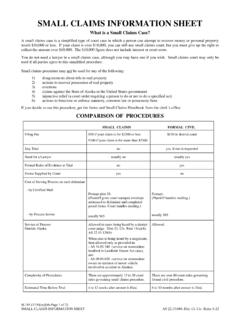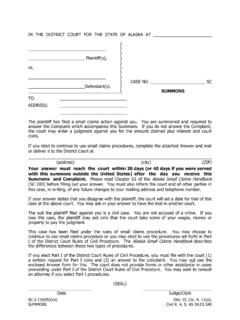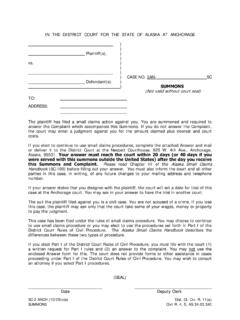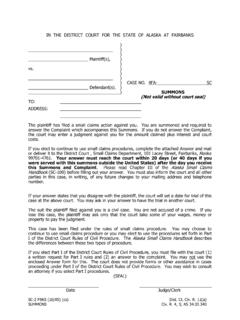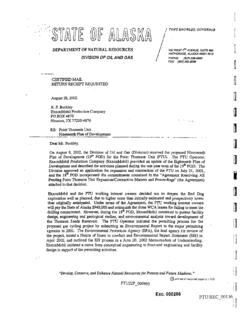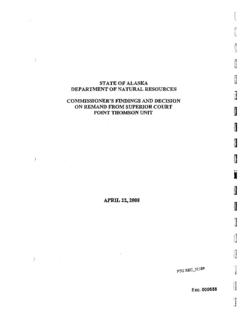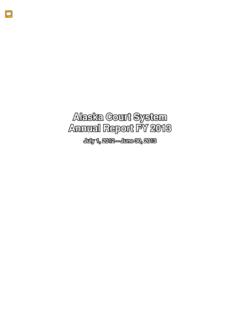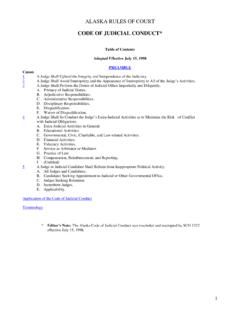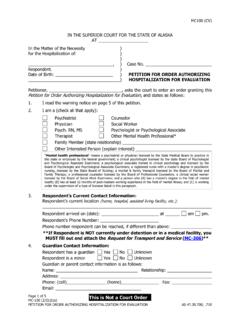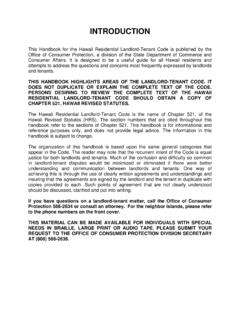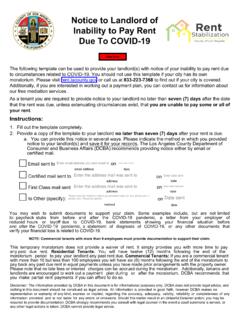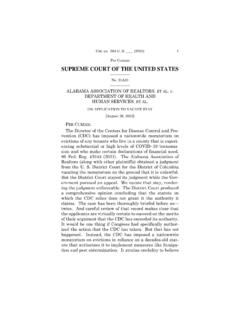Transcription of SC-100 Small Claims Handbook - Alaska
1 Alaska Small Claims Handbook August 2021 Alaska Court System The forms mentioned in this booklet are available on the court system s website: SC-100 (8/21) (green cvr) Prepared by the Alaska Court System Copyright 1985, 1986, 1988, 1989, 1990, 1991, 1992, 1993, 1994, 1997, 2001, 2004, 2005, 2006, 2007, 2008, 2009, 2010, 2011, 2012, 2013, 2014, 2015, 2017, 2018, and 2021 Alaska Court System All rights reserved. Permission to reproduce the contents of this Handbook , but not for profit, is hereby granted to governmental and educational institutions. However, reproduction of any part of this Handbook for commercial purposes without the express written permission of the Alaska Court System is strictly prohibited. TABLE OF CONTENTS Chapter I.
2 Introduction to Small Claims .. 1 A. WHAT IS A Small Claims CASE?.. 1 B. THE CHOICE: Small Claims PROCEDURE OR FORMAL PROCEDURE .. 2 C. WHO CAN FILE A Small Claims CASE .. 2 D. WHO CAN BE SUED IN A Small Claims CASE .. 2 E. HOW TO START A Small Claims CASE .. 2 F. HOW TO RESPOND TO A Small Claims COMPLAINT .. 2 G. FORMS .. 2 H. LAWYERS .. 3 I. SPECIAL SITUATION WHEN LAWYERS ARE NECESSARY .. 3 J. CAN SOMEONE OTHER THAN A LAWYER REPRESENT YOU IN A Small Claims CASE? .. 3 Chart: Comparing Procedures .. 4 Flowchart: Sequence of Events in a Small Claims Case .. 5 Chapter II. How to Start a Small Claims Case .. 6 A. BEFORE YOU FILE .. 6 B. FILING PROCEDURES .. 7 C. HOW TO FILL OUT THE FORMS .. 7 D. HOW TO GIVE NOTICE TO A Small Claims DEFENDANT .. 15 E. WHAT TO DO IF YOU CAN T SERVE THE DEFENDANT .. 16 F. DEFENDANT'S RESPONSE.
3 17 G. CHANGE OF ADDRESS, EMAIL, AND TELEPHONE NUMBER .. 18 H. SETTLEMENT PRIOR TO TRIAL .. 18 Chapter III. What to Do If Someone Sues You in Small Claims Court .. 19 A. WHAT TO DO IF YOU ARE SERVED WITH A SUMMONS AND COMPLAINT .. 19 B. IF YOU AGREE WITH WHAT THE PLAINTIFF SAYS .. 21 C. IF YOU DO NOT AGREE WITH WHAT THE PLAINTIFF SAYS .. 21 D. REPLY TO COUNTERCLAIM .. 24 E. CHANGE OF ADDRESS, EMAIL, AND TELEPHONE NUMBER .. 24 Chapter IV. Preparing for Trial .. 25 A. COLLECT EVIDENCE .. 25 B. CONTACT WITNESSES .. 25 C. SUBPOENA WITNESSES IF NECESSARY .. 25 D. PREPARE OUTLINE AND PRACTICE .. 25 Chapter V. Trial .. 26 A. BEFORE TRIAL .. 26 B. SUGGESTIONS ABOUT SETTLEMENT .. 26 C. DURING TRIAL .. 27 D. END OF TRIAL .. 27 Chapter VI. After Trial .. 28 A. HOW TO PAY THE JUDGMENT .. 28 B. INSTALLMENT PAYMENTS ON THE JUDGMENT.
4 28 C. JUDGMENT DEBTOR REFUSES TO PAY JUDGMENT .. 28 D. RELIEF FROM JUDGMENT .. 29 Appendix A: Small Claims Statute and Part II District Court Civil Rules .. 30 Alaska Small Claims Handbook 1 Chapter I INTRODUCTION TO Small Claims A. WHAT IS A Small Claims CASE? A Small Claims case is a simplified type of court case for a person to try to recover money or personal property worth $10,000 or less. If your claim is over $10,000, you can still use Small Claims court, but you must give up the right to collect any amount over $10,000. You may, however, recover interest on any money you are awarded and court costs over the $10,000 maximum. The person who starts the case by suing someone is called the plaintiff. The person who is sued is called the defendant. The plaintiffs and defendants are called parties in the case.
5 You do not need a lawyer in a Small Claims case, although you may have one if you wish. Small Claims court can only be used if all parties agree to use this simplified procedure. Small Claims procedure cannot be used for: disagreements about title to real property (land or buildings) actions to recover possession of real property (land or buildings) evictions Claims against the State of Alaska or the United States government injunctive relief (a court order requiring a person to do or not to do a specified act) actions to foreclose or enforce statutory, common law, or possessory liens This Handbook explains Small Claims procedure. It is based primarily on the District Court rules established by the Alaska Supreme Court. A copy of these rules is included in Appendix A. B. THE CHOICE: Small Claims PROCEDURE OR FORMAL PROCEDURE.
6 There are two different court processes to sue in district court: (1) Small Claims : an informal process for Claims up to $10,000. See the flowchart on page 5. (2) Formal Rules Case: may be used for Claims up to $100,000, including Claims for less than $10,000 if one of the parties so See flowchart at: For a comparison of these differences and others described below, see the table on page 4. Formality of Procedure: In Small Claims court, pleadings and other documents you file with the court are brief and do not need to follow all the conventions required under formal rules. The court also provides forms for Small Claims court, rather than you having to create your own pleadings from scratch. In a Small Claims trial, the judge can generally consider anything (with a few Small exceptions) that relates to the facts and will help the judge decide the case.
7 In a formal trial, the judge will apply the Alaska Rules of Evidence to decide what can be considered as evidence. If one side doesn t follow the Rules of Evidence, the other side can object to it. If the judge agrees with the objection, the judge or jury can t use that evidence to help make a decision. There are also stricter rules about questioning witnesses in a formal trial, and the judge usually will not ask any questions. In a Small Claims trial, there are no rules about the format of your questions and the judge often takes a more active role in asking questions. In a Small Claims case, the judge is allowed to investigate the claim on the judge s own initiative, in court or outside of it, as long as all the parties are present during the investigation. In a formal case, the judge is only allowed to consider evidence that the parties themselves bring to court.
8 1 Claims over $100,000 must be filed in superior court. Alaska Small Claims Handbook 2 Attorney Fees: If you win your case, the court can order the other party to reimburse you some of your attorney fees if you had an attorney representing you. In Small Claims court, the most you can get for attorney s fees is $ In formal civil cases, you can usually get between 3-30% of your actual, reasonable attorney fees, although there is no Keep in mind that in both types of procedure, if you lose your case, you would likely have to pay this same portion of the attorney fees to the other party if the other party is represented by a lawyer. Jury Trial and Judge: In a formal case, you have the right to pre-empt the assigned judge, as long as you follow the correct procedure to do so. To pre-empt a judge means that you can demand a different judge (one time only) without giving a reason.
9 In a Small Claims case, you do not have the right to pre-empt the assigned judge or magistrate judge. In a Small Claims case, your trial will be heard and decided by a judge or magistrate judge. You do not have a right to a jury trial in Small Claims cases. In a formal trial, you can demand a jury trial if you follow the correct procedure to request one. A jury trial can greatly increase the legal fees and costs in a case. C. WHO CAN FILE A Small Claims CASE. Anyone 18 years of age or older may A person under age 18 is allowed to file only with the assistance of a parent or guardian. Partnerships, unincorporated associations, limited liability companies, and corporations may also file Small Claims cases. D. WHO CAN BE SUED IN A Small Claims CASE. You can sue: Persons 18 years of age or older. Persons under 18, through their parent or guardian.
10 Partnerships, unincorporated associations, limited liability companies, and corporations doing business in Alaska . A landlord residing outside Alaska (see AS ). A nonresident owner or operator of a motor vehicle involved in an accident in Alaska (see AS ). If a person is outside Alaska , the person usually cannot be sued in Small Claims court unless a district court judge, rather than a magistrate judge, hears the case. This is because a magistrate judge may not hear a Small Claims case if the documents opening the case are delivered to the defendant outside the state, except in the last two situations in the bullet points listed E. HOW TO START A Small Claims CASE. Procedures for the plaintiff are in Chapter II. F. HOW TO RESPOND TO A Small Claims COMPLAINT. Procedures for the defendant are in Chapter III.
